A PDF, including all the graphics and charts can be found HERE
The Problem Restated
In a previous issue of American Surveyor (March-April, 2024) I stated the premise of the problem I wanted to solve.: Could I use an older theodolite from the 1970s to get a sight on Polaris which would allow an accuracy of at least six seconds of arc to establish true north for setting a telescope on polar alignment differently than traditional amateur astronomers techniques?
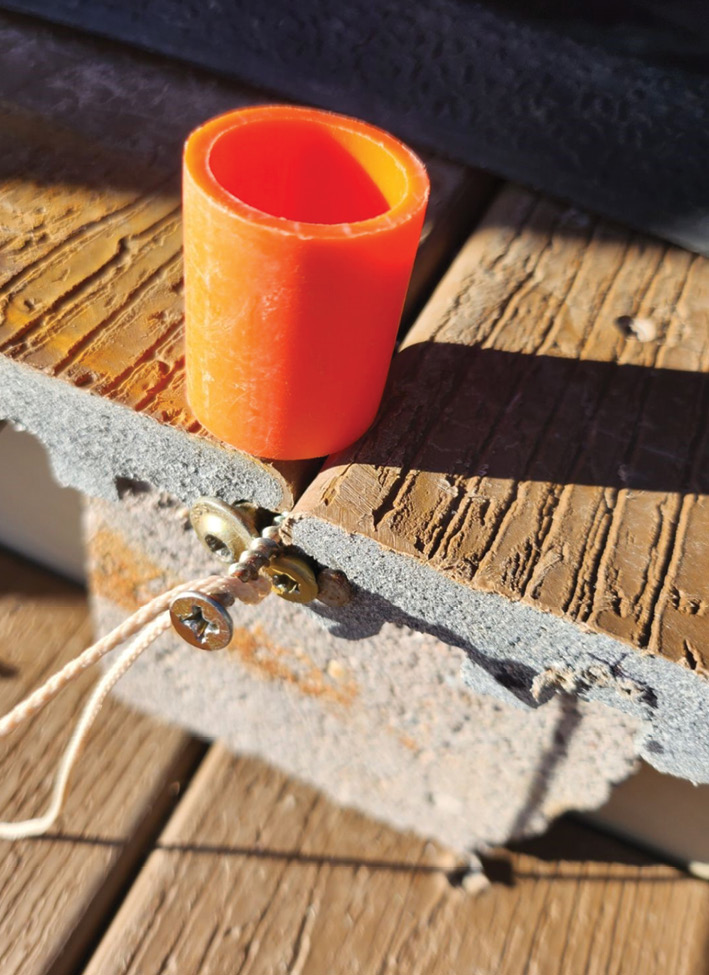
The two different screws set in the observatory deck for the azimuth of Polaris shots on five different nights either side of the one averaged to true north in the middle. The string line was used to align the telescope base plate.
The Problems Encountered
Saying that it might be possible to shoot Polaris for establishing true north to six seconds is not what it seems when dealing with old or even new equipment.
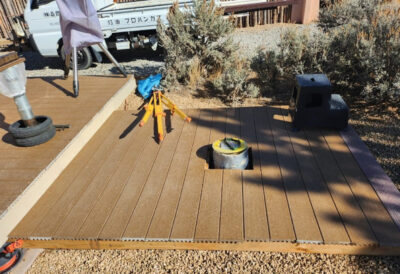
The TM-20C was blown away.
First, there is the overall state of the theodolite that has been unused for forty years. What shape was it in when I boxed it? I had two instruments to use, a slightly newer Sokkia TM-6 that could have a least count of six seconds, and an older Sokkisha TM-20C that could read to 20 seconds directly. Only the TM-20C had last been adjusted and calibrated in 1997 by a survey equipment repair shop.
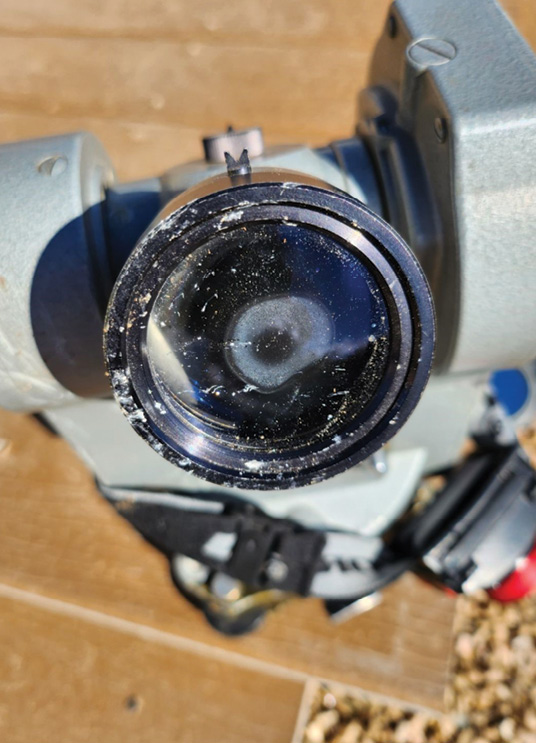
The TM-20C after the blowdown.
Second, when you use a pair of zenith eyepiece adapters on either one, they are fraught with slight aberrations that muddy up the sighting on Polaris. By introducing a right-angle prism in the optical path, it narrows the field of view by extending the focal length of the standard eyepieces. When using progressive glasses that are a composite prescription of trifocals also makes it hard to see because you cannot get your eyeballs close to the eyepiece as you could naked eye without them. At my 20-400 eyeballs without glasses, I am effectively blind at distances over two feet. Since Polaris is at an infinite distance optically, I could not see it without refocusing sans glasses and then being unable to write the numbers down without putting glasses back on in the dark. There is also a little bit of parallax between the crosshairs when sighting which causes a slight shift to the position of the crosshairs and the target star when you move your eye around.

Tribrach busted too after tumbling off the deck into the gravel.
Third, using the external window on the theodolite to illuminate both the crosshairs and the reading for the angles makes for hard seeing even with an attached battery light. There is a little prism in the barrel of the focus tube that can be set to provide illumination to light up the crosshairs. This is very sensitive to set without either swamping out the image of the star or making the crosshairs not visible enough. You can slightly defocus the star to make it larger to be better able to set on the exact center of the crosshairs, but it also makes it dimmer by spreading out the light.
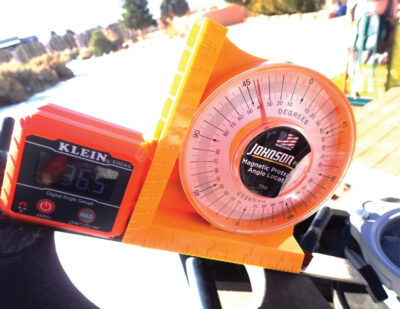
Digital and analog angle indicators on the telescope mount to set the latitude of the observing site near Taos, New Mexico.
Fourth, Polaris and all celestial objects are moving along with the atmosphere they are going through so scintillations caused by small and large shifts of wind can make the stars wiggle around in the eyepiece at magnification. Polaris especially changes in altitude about 1 minute, 14 seconds and 1 minute, 25 seconds in azimuth for every minute of time when at upper culmination at due north.
Fifth, you cannot double center the theodolite by going direct and reverse in opposite positions because the target is moving every second and you have only one time to take the shot. You’d have to take it another time but then it would not be in the same spot.
Sixth, the theodolite was on a framed wooden deck that was above and not in direct contact with the solid concrete pier below. So, whenever I moved to Polaris from the backsight it put the instrument slightly out of level. The plate bubbles on the TM-6 were calibrated to 20 seconds of arc for every tick mark. They would go out of level when I stood on the deck except in the same position that I would put my legs near the tripod when I took the shot. Luckily, I only had to move the instrument less than a degree from the backsight, so it was mildly out of level if I did not stand in the same spot each time. Even with this dancing around the tripod in the dark, I turned to the backsight to check back in, it would appear to be anywhere from about three minutes out from zero on the original backsight before the shot.
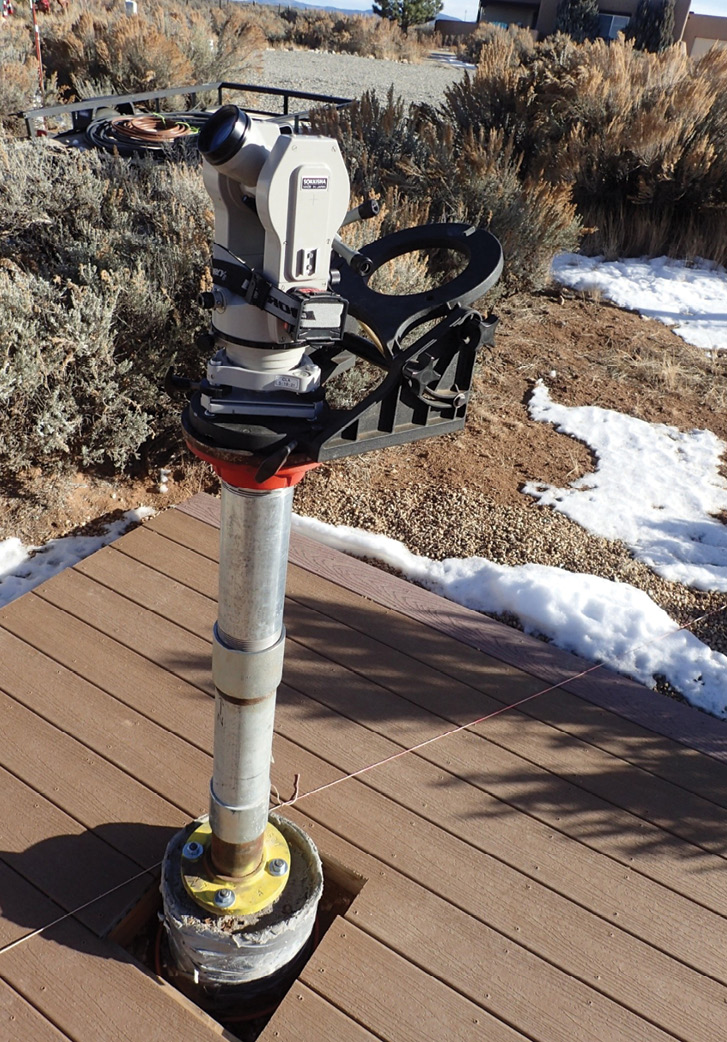
TM-6 Theodolite on pier mount.
Even with these human and equipment random errors I took enough shots with the TM-6 to get what I thought was an average of position fixes to produce a true north to turn the instrument. But after that there was another error, I had to account for in the readings. This involved using the less accurate TM-20C.

TM-6 Theodolite on pier mount.
I noticed that the TM-6 did not appear to have the cross hairs adjusted well enough to be good when I tumbled the gun to shoot level at 90 and 270-degree zenith angle. I took a level shot on a rod less than 12 feet away and it was out by almost a tenth when flipped. Also considered was that the horizontal compensator was not working because I did not hear the little jiggle sound for the auto level when lightly tapping the instrument.
I was going to use the TM-20C on the same tribrach to check if it did not agree with the level readings. But the best laid plans of survey mice and men had been thwarted when the TM-20C was blown away two nights before I was going to do the check, with 50 mph winds that put much needed snow on the Ski Resorts nearby. My 20 second gun toppled and was torn off its tribrach and badly damaged. Luckily, it wasn’t the TM-6 six-second instrument, but that put a crimp for my check on it to see if the horizontal compensator or crosshairs were out. l had to install the telescope with what I had for Polaris readings using the six second gun only. One thing that made me somewhat ignore the zenith readings was that I was primarily interested in the horizontal shots to get the azimuth while the vertical angles were of less importance to just check the altitudes against the ephemeris, but had less accuracy needed.
Here are the images of the Sokkisha TM-20C that the 50 mph winds blew down in the night that rendered it useless for further check shots against the TM-6 along with the tribrach.
Wrong Ephemeris, Remount Theodolite and Reshoot
After all these fumbling’s with the unknowns in the shots, I decided a new track was to mount the TM-6 on the pier itself. That was an initial problem because the telescope pier did not have the 5/8” x 13 threaded adapter for a typical survey instrument. Luckily, there was an adapter found from SECO at Capital Surveying Supplies in Santa Fe that had the standard threads on one end and a ¼” x 20 on the opposite. With a little more adaptation, I was able to put the TM-6 onto the equatorial wedge pier.
This eliminated all the other errors introduced into the prior setup that had the tripod on the deck that was not tied to the concrete pier embedded separately. The theodolite was now rock steady and didn’t go out of level when I danced around the deck.
I also discovered more errors from the planetarium program I used to generate the ephemeris for Polaris. I had entered the wrong latitude and longitude for my viewing location in El Prado, NM using Taos over 12 miles further south as the observing site. This involved resetting it for my site using a GPS enabled camera to check against the Google Earth data. It agreed within a few tenths of a second. After correcting this I shot another series on December 10th, 2023, starting in the evening at 9:00 to 11:10 PM every 10 minutes. As the evening temperatures steadily dropped well below freezing my gloved hands had less acuity in the legibility after running the zenith and azimuth cold aluminum tangent screws ungloved on the theodolite.
Having done that I reduced the zenith angles to altitudes to compare with the ephemeris and found that it was about zero degrees, twelve minutes, and thirty-nine seconds out in azimuth compared with that of the reading it should have been for true north (zero degrees) at upper culmination.
The vertical angles also revealed that the altitude started to decrease at the same time after 9:45 pm when Polaris had peaked and started to go down after that.
The next day I turned the corrected angle to set another screw in the deck boards 10 feet away for the true north reference mark to align the wedge. I then removed the instrument and string lined the pier to coincide with the corrected azimuth mark.
Thanks to the handy dandy magnetic digital levels that read to the nearest tenth of a degree, I was able to set the equatorial wedge to my latitude of 36.5 degrees North and as plumb as I could adjust it with the four ½” pier anchor bolts.
Of all the uncertainties in the readings I was very comfortable with the timings because I used a program on my cell phone that read out the hours, minutes, and seconds with a red LED display. I assumed this was good from the GPS satellites or whatever is used to give the correct time that handily changes when you arrive at an airport in a different state’s zone.
I know that a string line and back sighting a screw only ten feet away is going to introduce errors, but the telescope pier wedge does not have the fine adjustments than a 6” theodolite. However, I subscribe to the surveyor’s measurement mantra: you start out as tight as your equipment can do and then can get sloppy with less accuracy, but you can’t go the opposite way.
In this case the telescope only needs to be within a few minutes of arc to be acceptable and five minutes overall to track the stars without drifting out of the field of view under medium magnification.
The final step was to mount the scope onto the pier to see how well it does with the north line as set. The weather in Taos, New Mexico does not have friendly night skies from January to the end of April judging by the wind and below freezing evening temperatures. But finally, by almost the last week of April the mountain chickadees and rufus hummingbirds make their appearance signaling it’s safe for them to mate and stay for the summer.
But the weather here in Taos has been windy and rainy most every evening from what they call the spring monsoons. So, I have not been able to check the Polar alignment and probably won’t get at it until I get back from AK around Labor Day after I fly there on the 25th of May 2024. I don’t know how to end this phase of the article except to say adios amigos until I get back to finish the project in the fall. I had to abandon the final alignment test in favor of catching the midnight sun back in AK for the summer where there is only one star to follow that’s only 93 million miles away, up all the time, and not hard to track.
Martin Gutoski has been an amateur astronomer since 1974, an Alaskan Professional Land Surveyor since 1988 and holds a BA and MA in Archaeology from the University of Alaska Fairbanks in 1992 and 2003, respectively. He has lived in Alaska since 1960 but overwinters (snow birding as it is called) in Taos, New Mexico since 2017 to avoid any more winters there but returns to Fairbanks from Memorial Day to Labor Day to do archeology and land surveying when the snow is gone and the sun is up 24/7.
Sidebar
Historical Interest
Although surveyors seldom use Polaris to get their north fix now, I had a party chief in Prudhoe Bay when I was an instrument man in 1974. I couldn’t stay outside running the instrument in the winter for more than an hour because it was normally 30 below with a 20-knot wind that made the chill factor greater than 50 below. It was dark with not much light in November or no sunlight around winter solstice at 70+ degrees north latitude. He would stay in the survey rig and roll down the window a crack so I could yell out the readings for him to write down in the field book and only come out as he had to lower the gas-powered light plant boom that was towed behind the truck when we moved to illuminate the next setup. As I scurried back to the truck between setups, shoving my fish belly white frozen fingers into the defroster ducts in it, he would regale me with his survey adventures working for the Army Corps of Engineers in Alamogordo, New Mexico just before he worked with me. One of the most interesting was shooting Polaris for five nights to get a true north bearing. They needed to extend a track brought from Edwards Airforce Base in California of 20,000 feet to Holloman AFB in Alamogordo near White Sands Missile Range to ten miles long oriented nearly north for the rocket sleds that pushed monkeys, men, and live pigs to speeds of Mach 1 in five seconds and later payloads of equipment sans living beings to nearly Mach 6. Today it is the longest straight line measurable with a bearing of exactly 356 degrees in Goggle Earth. It is less than 360 because they had to account for the subtle differential vectors of earth’s rotation in that distance at that speed.
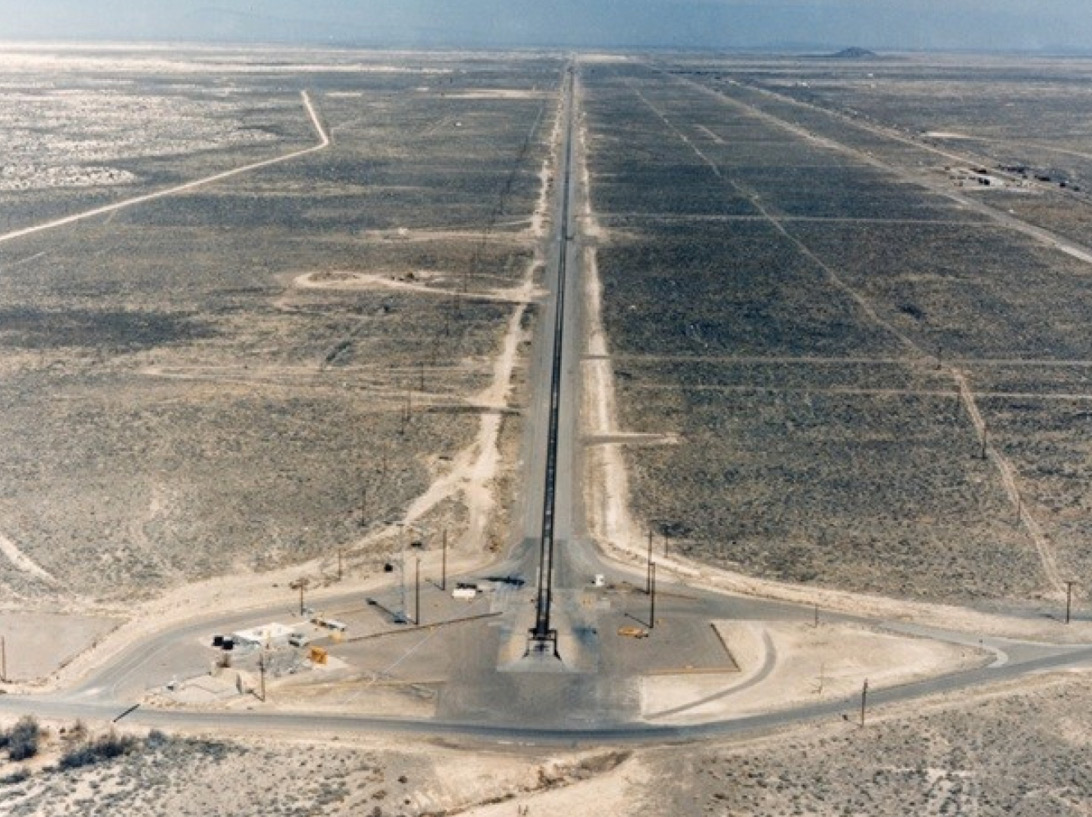
Google Earth View of Holloman AFB in Alamogordo, NM at High Speed Test Track next to White Sands on the upper left.